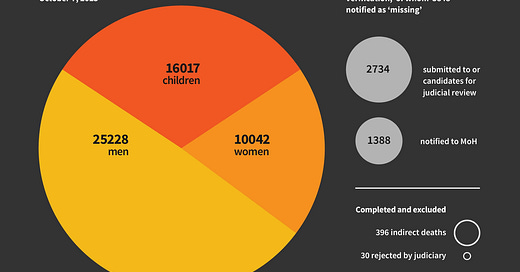Gaza’s victim details and victim deniers
The Ministry of Health casualty lists and the attempts to dismiss them
We continue our series on the casualty recording being conducted in Gaza under Israeli attacks. The effort to document every resident killed involves officials, medics, local journalists and the families, friends and neighbours of victims. At its centre is a pioneering achievement by Gaza’s Ministry of Health (MoH) which is constructing—with unequaled transparency and while under deadly fire itself—a name by name list of each victim. Yet this very openness and work-in-progress visibility has allowed some to label list updates and changes from one version to the next as signs of fraud. We demolish some of these claims and provide fresh evidence of the list’s continual improvement.
The massive and daily increasing death toll in Gaza should be of urgent concern to any organisation that can offer informed insight and counter mis- and dis-information about it. Iraq Body Count (IBC) has decades of experience in working with casualty records and a good understanding of the methods and challenges faced by our peers working on other conflict zones. As part of a larger project dedicated to humanising Gaza’s victims, IBC has given close attention to the lists of named victims released by the Gaza Ministry of Health (MoH).
The more complete, detailed and error-free a casualty list is, the better the statistics that can be drawn from it. But documenting the dead also serves a deeper purpose: the basic human and societal need to know not only how many were killed, but who was killed. What matters to the public record, then, is that everyone who belongs on a list of the dead is on it; that those who do not are removed; and that all the details associated with each individual are correct.
Even under ideal conditions constructing such a list will likely involve mistakes of omission and commission, but the results won’t be compromised if mistakes are addressed. And, despite operating under a relentless military onslaught, such constant improvement is exactly what we are seeing in the MoH’s evolving documentation.
There are however a few who have denounced mistakes in the MoH lists (and even more unreasonably, their correction) as signs of fraud (‘fakery’, ‘patently falsified’, ‘clearly manipulated’). The allegations include that
- removal of individuals from one list to the next is evidence of fraud;
- male deaths have been recorded as female to evoke greater public sympathy;
- and child deaths have been similarly manipulated.
We address these allegations because they involve the age-old tactic of citing minor errors to dismiss as ‘enemy propaganda’ overwhelming evidence of war crimes and civilian massacres.
Even allowing that there’s some value in genuine errors being pointed out (whether with good intent or otherwise), any errors are now overshadowed by the sheer volume of names since added to the timeframes covered in MoH lists. These additions were exclusively described in our first Substack article on Gaza:
On closer examination, far from exposing fraud, these accusations only confirm that the MoH is exercising due care and professionalism in its work.
On this matter we recall an insightful remark that caught our attention 21 years ago:
On 29th October 2003 the official 9-11 death toll was reduced from 2,792 to 2,752 when 40 potential deaths were eliminated from the count. Here is a telling extract from the New York Times for that day:
Do we grieve less? Are we happy? What does it mean? “The question is, does it make it any less tragic?” said Jonathan Greenspun, the commissioner of the Mayor‘s Community Assistance Unit. “The answer is, no, it doesn’t.”
The change in the number … reflects the best in human nature, city officials say, as personified by investigators so intent on determining the true and sacred number of the dead that they properly took their time, even if it meant that a few fraudulent names, or the names of the living, were sprinkled among those of the many dead. Better that, they reasoned, than to exclude the name of one true victim.
The mission to specify the number of victims has been a necessary one: partly for history, partly for the distribution of death benefits — and partly to satisfy a communal desire for a number whose exactness might bring some comprehension to the incomprehensible.
We agree with every word of this. And all of it also applies to Gaza's victims, just as it does to deaths in Iraq.
Transparency, not fraud
The most repeated and headlined criticism of the MoH victim lists concerns the ’removal’ of names from one list to the next, allegedly because they were fraudulently inserted in the first place. In particular an obsessive MoH denouncer declared the disappearance of some ID numbers previously present as evidence of “fakery” and “manipulation”. At issue were 881 ID numbers contained in the June 30, 2024 list he was unable to discover in later ones, including the list released on March 23, 2025.
We examined these cases and have so far found that 100 of the supposedly “removed” victims are not missing from the March list. They simply had their ID number (and sometimes other details) changed to correct them.
Some of these same victims have also been pictured and memorialised on social media by friends and relatives. We show four of the memorials known to us in the Appendix below, where we also list all 100 individuals with their published details.
Further, among the 881 ID numbers we found 564 that do not meet Palestinian ID validity checks, and can only have been at best provisional or containing errors. This means they were always destined for removal or replacement, as any close observer would know.
What accounts for ID numbers requiring amendment? Some IDs have data entry errors, including typos. Others are provisional/emergency ID numbers, to be replaced with IDs from the national register once identification is complete and a death certified. This can take time, not least because identification may often require the examination of fragmentary human remains, an all too common occurence under Israel’s bombardment.
No shortage of victims
A similarly misguided line of attack was over the apparent removal of 1080 children across two other lists, the accusation being that they were only inserted in the first place to evoke sympathy and shift the child/adult balance. This scarcely merits attention, given that under the visible process of improvement adults too were being removed or having their details changed, and in greater numbers.
In any case, the lists in question contained 34344 and 40717 deaths respectively, of which 12655 and 13456 were children. Removing 1080 (less than 10% of children) from these lists hardly turns an unacceptable child death toll to an acceptable one, so explanations in terms of fraud are just not credible.
It is now clear that an early priority of the MoH was to add all the names of victims known to them to the public list so that Gaza’s citizens could see who they were. Among other things, this allowed families to report victims not yet on the list. This is exactly the right thing to do, and something which other actors (such as the US DoD in the Iraq War) have been rightly castigated for failing to even consider.
As hospital–based recording systems became progressively degraded under fire the MoH announced means for relatives to submit details of their killed or missing loved ones using an online form. These notifications were not subject to the full procedures of hospital registered deaths, and subsquently a substantial batch of them (around 10% of the total) were removed for more detailed verification.
In the last few days we have obtained additional evidence that entries removed from earlier published lists are not simply excised (as might be the case were fraud at play) but remain in an internal MoH list of all hospital and family reported victims, including those marked as needing verification. We have had access to a version of this list dated April 10th 2025 which shows the status of entries still in the system, whether in the process of verification or now permanently excluded, which we summarise in the graphic below.
In this working list 51287 individuals are placed in the category of the certified killed, as of April 9. (This number represents the largest and most recent toll of identified victims in Gaza since October 7, 2023 and is an increase on the 50020 deaths in the March 23, 2025 list.)
The graphic also shows the number of unpublished and in–process entries, most of which originate from notifications by families of missing relatives. The largest category is 2734 names which have been submitted to (or qualify as candidates for submission to) judicial review. Many of these will likely return to a future public list once certified. The next largest category (1388) are entries “notified to MoH” mainly by families, which are not yet ready for judicial review.
Among the excluded are 396 deaths the MoH has determined to have been indirect. The MoH has previously told the media that this category includes all deaths that are not the result of weapon-caused physical trauma, even if such deaths were clearly connected to IDF actions.
A tragic case of this ‘indirect’ category is present in our own compilation of online memorials, who died on 6 January 2024. Her name appeared in the April, June and August 2024 public lists but was removed from the October 2024 list onwards. A public memorial posted on X by @Gaza_Shaheed in October 2024 reveals that she was a cancer patient who died three months after her ongoing treatment ceased due to Gaza coming under attack.
It could be argued that a person dying like this is in fact a direct victim of armed violence; leaving that to one side, the removal of such cases indicates the MoH is employing stringent inclusion criteria as it refines its lists.
Extreme pettiness to distract from extreme violence
Far too much has also been made of a claim published in December 2024 by the Henry Jackson Society (hereinafter HJS). This alleges that in the sixth list covering up to August 31, 2024, MoH miscoded 103 men as women and “systematically inflated the death toll by... over-reporting fatalities among women.” (Similarly insignificant and flimsy claims are made about children—we focus only on allegations concerning women here, which suffices for both.)
The minuscule effect of this alleged change to the gender profile among 34344 of Israel’s victims in Gaza is shown in our graphic. The claimed 103 men-miscoded-as-women is the single white dot, shown in relation to all the other men, women and children recorded killed in the same August 2024 list.
Moreover as others have noted, for this to be evidence of “systematically inflated” numbers of women one needs to show that women were not also, or not nearly as often, mislabelled as men. This obvious (and necessary) measure was apparently not attempted by HJS authors.
Our own initial analysis of the August list revealed more cases than identified by HJS, but showed that as many women were miscoded as men, as men were miscoded as women.
To discover this, we first reduced the data set to 22989 adults aged 18 years and older, as HJS refers to “men” and “women,” not just males and females. We then determined which first names were predominantly (but not solely) assigned to men and which to women, and treated every assignment to the minority sex as a potential mistake.
Using this logic, we found
156 men-miscoded-as-women
160 women-miscoded-as-men
—among the 22989 adults in the August 2024 list.
These are very small proportions, and with almost equal numbers going both ways. But there are over twice as many men as women in the list (15555:7434), providing double the opportunity for miscoding men’s details. On those grounds alone we should expect to see many more miscoded men than miscoded women; we did not.
The purely algorithmic method we employed has the advantage that it requires no knowledge of local naming conventions. But it has limitations. Some Arabic first names can be assigned to either sex (e.g. Nour, Wesam). Even when the tendency is strongly towards one sex, the assignation to the other may not be a mistake. Without reference to official population registries it is impossible to tell from a name list alone whether an individual with a unisex name has been assigned the wrong sex. Therefore many of the opposite sex assignments revealed above may not be miscodes at all.
We took some account of this by filtering out the following popular unisex Arabic names that appear in the dataset, since these will normally contain both sexes in uneven proportions, with no relevance to miscoding:
When this is done the number of “sex miscoded” cases in the August 2024 names list reduces to:
85 men-miscoded-as-women
81 women-miscoded-as-men
This more culturally-aware adjustment reduces overall “miscoded” entries by 47%, leaving slightly more miscoded entries among men (but not nearly the expected twice as many).
Results from an updated dataset
As we have previously shown, the number of victim names in all published MoH lists, including for the period covered by the August list, have risen substantially in later updated lists. There are now 41976 named dead for the same period (increased from 34344). Applying our first (unfiltered for unisex) analysis to this updated list of individuals killed results in:
91 men-miscoded-as-women
122 women-miscoded-as-men
—an absolute reduction in miscoding, despite its being a longer list with an additional 5531 adult deaths. Applying our unisex names filter gives:
17 men-miscoded-as-women
23 women-miscoded-as-men
—among 28520 adults recorded killed in the period from October 7, 2023, to August 31, 2024.
The results are summarised in the table below.

These findings allow us to confirm once more that the MoH is steadily improving the accuracy of its records while adding substantially more individuals for the periods covered in earlier lists.
Nothing to see here but casualty recording
Casualty recording—or we might also call it victim documentation—is the process of gathering, assessing, organising, and sharing information that contributes towards building the fullest possible list of victims, with their name, demographics and other key details.
During periods of high-intensity armed violence the information that can be collected and processed will necessarily be imperfect as well as incomplete, hopefully with improvements to come. Good practice means making those improvements sooner rather than later. This includes the correction of errors, the verification and addition of deaths, and greater detail. A small MoH example of this: many provisional dates of birth have been updated from giving only the year and “January 1” as a placeholder date to be replaced by the actual month and day. Everything we have seen in successive published MoH lists since June 2024 provides clear evidence of such processes under way.
If the errors, ‘removals’ and changes discussed here were in fact the product of fraud they would be both pointless and inept. Pointless, because they make such a small material difference to the massive, and largely civilian, death toll of Israel’s attacks as already recorded by the MoH. And inept, because all the changes are readily visible to anyone who imports the lists into a spreadsheet and studies a few columns.
Would their accusers even know about changes to the MoH lists if a clean-up process was not being carried out in full public view? It seems the MoH’s very transparency provides the straws they so desperately grasp at.
Transparency in victim documentation as displayed by the MoH is by no means the norm. This opens the results of their work to public scrutiny (including the adversarial) even before it is finished. They seem to think that a price worth paying, as should all who believe that human lives lost to armed violence should be known, even if imperfectly, as soon and as comprehensively as possible.
IBC is reader-supported. To receive new posts and support our work, consider becoming a free or paid subscriber (IBC’s Substack content will remain free for all subscribers, paid or unpaid). You can also make single donations.
Appendix:
A list of 100 individuals with updated details mistakenly claimed to be missing from the public list released in March 2025.




Of the 100 individuals listed here, some have also been the subject of online memorials. Four that are known to us are shown below.
Memorial on X @GazaShaheed: His mother wrote, “Rakan has a cheerful face and good manners, and is completely committed to prayer despite his young age. Strangers wept for him before relatives. Rakan was and still is in everyone’s heart.”
Memorial on X @GazaMartyrs: Hudhaifa was a bright child with many hobbies including soccer, his dream was to play professionally. He was never able to achieve his dreams as Hudhaifa was martyred along with his family by an Israeli airstrike.
Memorial on X @GazaMartyrs: “Hays had only two years left to graduate from her major, but the Israeli occupation took her before she could celebrate” Haya's family home in Deir Al-Balah was targeted by Israeli airstrikes. Haya, along with her mother, aunt Aisha, brother Mohammed, and sister Arwa, were martyred.”
Memorial on X @GazaMartyrs: Abdel “spent most of his life in the UAE and came to Gaza to complete his university studies in the field he dreamt of, "engineering." He loved Gaza, its streets, its life, and always expressed that in his writings. Along with his sister, [he] was martyred in an Israeli airstrike.”
IBC is reader-supported. To receive new posts and support our work, consider becoming a free or paid subscriber (IBC’s Substack content will remain free for all subscribers, paid or unpaid). You can also make single donations.










